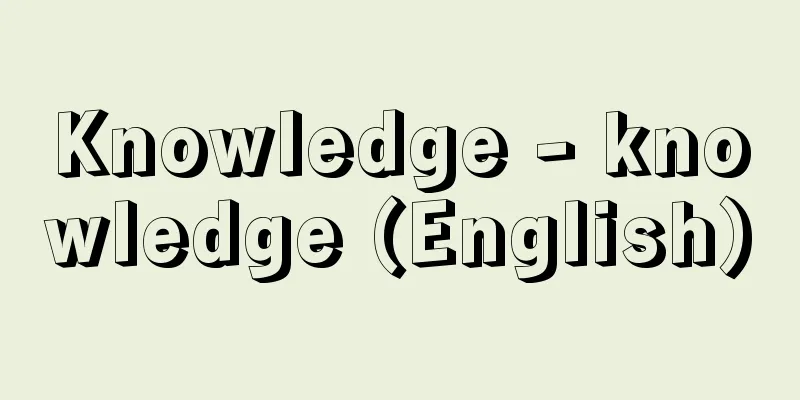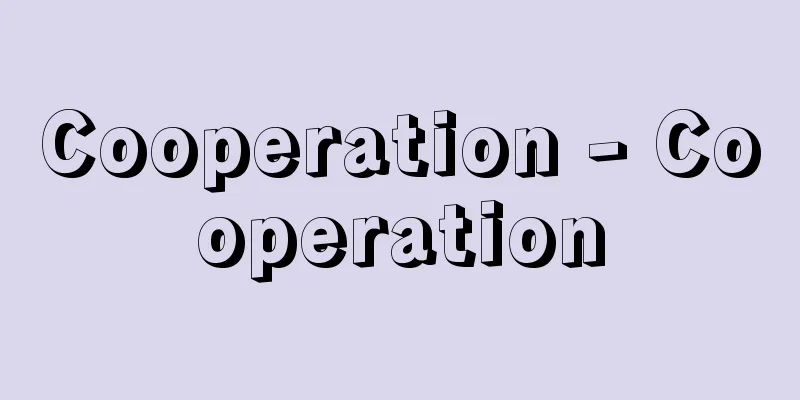Knowledge - knowledge (English)

|
In cognitive psychology, which uses computers as a model of human mental processes, knowledge is defined as information about the outside world stored in memory. However, the definition of knowledge has long been debated by philosophers, linguists, and psychologists, and even in modern psychology, there is no uniform understanding of knowledge depending on the theory. [The distinction between declarative knowledge and procedural knowledge] Knowledge can be divided into declarative knowledge and procedural knowledge. This distinction can also be seen in the ancient philosopher Ryle, G. (1949)'s distinction between "knowing that" and "knowing how." Declarative knowledge corresponds to "knowing the facts" and is knowledge of facts, events, and concepts. It is expressible linguistically, is explicit, and can be used consciously. Procedural knowledge corresponds to "knowing how to do something" and is knowledge about cognitive and motor skills that require skill. Procedural knowledge is difficult to verbalize and cannot be used consciously. For example, one can explain the structure and running mechanism of a bicycle (declarative knowledge), but one can only demonstrate how to ride a bicycle (procedural knowledge) by actually riding it. Procedural knowledge includes the knowledge that is the basis of skill learning and priming. Skill learning refers to the acquisition of motor skills such as how to drive a car and cognitive skills such as how to program a computer. According to Anderson, JR's ACT model, skill acquisition initially relies on declarative knowledge, but with repeated practice, it shifts to the use of procedural knowledge expressed in production rules. Skill acquisition goes through three stages: cognitive, associative, and autonomous stages. In the cognitive stage, knowledge is still expressed declaratively (often verbal), and attentional load is high. In the associative stage, linguistic mediation is reduced through practice, rules are learned, and they begin to be used unconsciously. In the independent stage, declarative knowledge is transformed into procedural knowledge, and rules are applied automatically, resulting in faster and more accurate execution of actions. The division of declarative and procedural knowledge was also influenced by research on amnesic patients, and Squire, L. proposed a memory system based on this division and classified memory into declarative and procedural memory. Procedural memory includes skills, priming, conditioned responses, habituation, etc. Amnesic patients retain the procedural memories they already had. Among declarative memories, episodic memories are called explicit memories because information can be consciously recalled. In contrast, procedural memories, along with semantic memories and priming memories, are called implicit memories because they depend on knowledge that cannot be consciously recalled. [Distinguishing between episodic and semantic memory] Tulving, E. (1972) proposed dividing declarative memory into episodic and semantic memory. Episodic memory is the memory of events or phenomena that have been personally experienced. The laboratory memory experiments pioneered by Ebbinghaus, H. (1885) can be said to measure episodic memory. In the 1970s, under the influence of computer science and artificial intelligence research, research on human knowledge structure and its operation became active, and memory of general knowledge about the outside world was defined as semantic memory. Tulving (1985) also distinguished episodic and semantic memory from the perspective of conscious experience at the time of retrieval. Episodic memory is autonoetic, and specific contextual information such as time, place, sound, smell, and brightness when an event was experienced is recalled together. Semantic memory is cognitive noetic, but it is stored separately from actual experience and does not include information on when and where the content was learned. Tulving later emphasized the aspect of episodic memory in which we recall personal events and relive them from the past, which he called "mental time travel." To experimentally verify this supposed distinction between episodic and semantic memory, memory tests were devised that required two types of judgments: "remember" or "know" information. "Remember" judgments involved conscious recall of details of a learned item and were considered to measure episodic memory. "Know" judgments, on the other hand, indicated a sense of familiarity without detailed memory and were considered to reflect semantic memory. Studies have investigated whether "remember" and "know" judgments are affected differently by various experimental variables, and the extent to which these procedures reflect the underlying memory system has been a topic of debate. Neuropsychological data suggest that amnesic patients are impaired in their ability to retain new information, but memory impairments usually occur in episodic memory, although retrieval from semantic memory is often possible, adding to the evidence for a dual memory division. Semantic memory was defined by Tulving (1972) as follows: "Semantic memory is essential for using language. It is a mental thesaurus, a systematic knowledge that people have of words and other linguistic symbols, their meanings and referents, relationships, rules, formulas, and algorithms for the manipulation of these symbols, concepts, and relationships." In other words, the mental thesaurus is a mental encyclopedia with more extensive information than the mental lexicon, which is the representation of words in long-term memory. Semantic memory is general knowledge about the outside world and does not include the specific time and space information in which they were learned. Semantic memory research has examined how knowledge is structured and how it is used. [Models of semantic memory] Representative models of semantic memory include the hierarchical network model, the feature comparison model, and the spreading activation model. 1. Hierarchical network model Collins, AM and Quillian, MR (1969) proposed that knowledge is represented as a hierarchical semantic network. As shown in Figure 1, a semantic network is represented as a hierarchical structure in which concepts are linked to each other from higher concepts to lower concepts. Each concept corresponds to a node, and concepts are connected by links. The links are labeled to indicate the connection between the nodes, and indicate the inclusion relationship between concepts and the attributes of the concepts. In this structure, each concept (e.g., "canary") is positioned below a higher general concept (e.g., "bird"). Each concept is also connected to the attributes that characterize it (e.g., "yellow" and "singing"). Attributes common to a group of concepts are stored only in the highest concept, not in each concept. This is called the principle of cognitive economy. Collins and Quillian attempted to verify their model by measuring reaction time in a sentence verification task. According to the assumptions of the model, the greater the level difference between concepts or attributes that must be searched, the greater the reaction time. For example, it was predicted that reaction times would be longer for "canaries are animals" than for "canaries are birds," and the experimental results were consistent with this. However, the model also showed results that could not be explained. First, although both "canaries" and "ostriches" are examples of the category "birds," the model cannot explain the phenomenon that judgment times are longer for sentences about atypical examples such as "ostriches are birds," even when the hierarchical level difference is the same (typicality effect). Second, although "mammals" are a subordinate concept of "animals," the model found that judgment times for "collies are mammals" were longer than for "collies are animals," which does not match the predictions of the hierarchical structure. 2. Feature Comparison Model Smith, EE et al. (1974) proposed that concepts are represented in semantic memory as a set of semantic features. The features that make up a concept are divided into defining features and characteristic features. Defining features form the core meaning of the concept and are necessary and sufficient features. Typical features are features that characterize the concept, but are not necessarily necessary for the definition. The truth or falsity of a sentence is judged in a two-stage comparison process. In the first stage, all of the defining and typical features are compared to judge the similarity between the two concepts. If the similarity between the two is very high, a judgment of "true" is made immediately, and if the similarity is very low, a judgment of "false" is made immediately, and the reaction time is short. If the similarity is moderate, the process proceeds to the second stage, where only the defining features are compared to make the judgment, resulting in a long reaction time. By assuming such a two-stage comparison process, the feature comparison model is able to explain the typicality effect, which could not be explained by the hierarchical network model. Typical cases have a higher similarity of features between them and the superordinate concept than atypical cases, so they can be judged in just the first stage, resulting in a quick response. However, the problem with the feature comparison model is the distinction between defining features and typical features. For example, an artificial concept such as an "equilateral triangle" has a defining feature, and without it it cannot be called a triangle, but for naturally occurring concepts such as "furniture" and "birds," it is not possible to find a defining feature that is possessed by all of the members of the category (things or events). 3. Spreading activation model Collins and Loftus, EF (1975) developed the spreading activation model to solve the problems of the hierarchical network model. First, they abandoned the hierarchical structure as being inflexible, and instead assumed a network based on semantic associations. As shown in Figure 2, the length of the link between concepts represents the strength of the semantic association between them, with shorter links indicating stronger associations. As for the processing process, they assumed that when a concept is seen or heard and processed, the corresponding node is activated, and activation spreads to other concepts connected to it. Activation spreading through the links decays in proportion to the distance between concepts, the number of activated links, and the passage of time. For example, the semantic association between "canary" and "bird" is higher than that between "ostrich" and "bird," and the link is shorter, so activation spreads faster, which predicts the typicality effect. One of the phenomena that can be predicted by the spreading activation model is the semantic priming effect. Meyer, DE and Schvaneveldt, RW (1971) performed a lexical decision task in which two letter strings were presented in succession and participants were asked to decide whether they were words or nonwords. The results showed that when the first and second stimuli were semantically related words (e.g., "bread" and "butter"), the decision time for the second stimulus was shorter than when they were not (e.g., "nurse" and "butter"). According to the model, when the first stimulus is activated, activation is predicted to spread to related words, which can be interpreted as accelerating the processing of the second stimulus. [Representation] When knowledge is stored in memory, it is separated from the substance of the object and is represented internally through a process of generalization and abstraction. A representation is a set of notations or symbols that represents an object even when the object is not present, and identifies things, events, concepts, categories, or their characteristics. Representations have two aspects. One is the form of expression through which the representation conveys information. The other aspect is the content or meaning that a particular representation conveys, and the same content can be conveyed in multiple forms. 1. Classification by form of representation Representations can be divided into propositional representations, analog representations, and connectionist models based on their form of expression. Propositional representations are similar to language, and are abstract, unrelated to the sensory stimuli at the time the information is input. In contrast, analogical representations are imaginative, correspond to specific sensory modalities such as vision and hearing, and are concrete. The spatial properties of images have been demonstrated through experiments such as mental rotation and image scanning. The connectionist model adopts the neural circuit network of the brain as a model of human cognitive processes, and assumes a network of connections between simple units that correspond to neurons. It also assumes that concepts are represented not by specific units in the network, but by activation patterns between units. A proposition is the smallest unit of knowledge that can be questioned as true or false, and represents a single, simple idea. In this case, idea refers to a wide range of mental representations, including concrete objects, concepts, the meaning of sentences, and the contents of thoughts. A proposition consists of a predicate and one or more arguments. Arguments basically correspond to concepts represented by individual words, and sometimes to other propositions. Predicates indicate the relationship between the arguments, and can include verbs, adjectives, conjunctions, time, and place. There are various ways to write propositions, but in a general predicate calculus, the predicate is written first, and then the arguments are listed in parentheses. For example, the sentence "Mozart gave the duke a beautiful concerto" can be expressed as a list of two propositions: "give (Mozart, concerto, duke), beautiful (concerto)." The sentence "The duke gave Mozart a beautiful concerto" is equivalent in the proposition list, and the same semantic content can be extracted regardless of differences in language, grammatical form, or vocabulary. Another notation for propositions is the network representation. According to Anderson (1980), each proposition is represented as an oval and is connected to predicates and arguments by labeled arrows. The propositions, predicates, and arguments are called nodes of the network, and the arrows connecting the nodes are called links. The labels on the links indicate the type of connection between the nodes, and include relation, actor, object, and recipient. Figure 3 shows a propositional network representation of the sentence "Mozart gave the duke a beautiful concerto." 2. Classification by content of representation Representation of information in long-term memory is called memory representation. The formation of memory representation is influenced by knowledge about the outside world. When memorizing meaningful material such as a sentence or a text consisting of multiple sentences, the overall meaning or gist is recalled, not the surface aspects such as verbatim words and phrases. Kintsch, W., in his model of text comprehension, states that memory representation is formed at three levels: surface form, text base, and situation model. The surface form preserves the form and verbatim wording of the sentence. The text base is a propositional representation that extracts only the meaning of each sentence. A situation model is a representation of the situation of the event, action, person, etc. that it describes, rather than a representation of one or more sentences (texts) themselves. A situation model is constructed using existing knowledge in addition to the sentence or information obtained from the text. Kintsch examined the strength of three levels of memory representation in a sentence recognition experiment and showed that retention time was longest for surface form, followed by text-based and situation model. The representation of a word in long-term memory is called the lexical representation, or mental lexicon. Lexical representation includes all information about the word, including orthography, phonology, and syntax in addition to meaning. The problem in understanding and producing a word is how to retrieve this information from the lexical representation. Many models assume three levels of representation: semantic, syntactic, and phonological. For example, language production is the process of converting the concept underlying a word into speech, and is the process of converting the semantic representation of the content of the word into a phonological representation as a formal aspect in accordance with grammatical constraints. →Memory →Schema →Neural network model →Cognition →Cognitive psychology →Priming effect (Kawasaki Eriko) "> Figure 3 Representation of sentences using a propositional network (Lachman, R. et al., original work, 1979, Kawa_Eriko, "Long-term Memory II: The Structure of Knowledge," in Yotaro Takano (ed.), Cognitive Psychology II: Memory, University of Tokyo Press, 1995) Figure 2. Spreading activation model (Collins & Quillian, 1969, Eriko Kawahara, "Long-term Memory II: The Structure of Knowledge," Yotaro Takano (ed.), Cognitive Psychology II: Memory, University of Tokyo Press, 1995) Figure 1 Hierarchical network model Latest Sources Psychology Encyclopedia Latest Psychology Encyclopedia About Information |
|
知識は,人間の心的過程のモデルとしてコンピュータを採用した認知心理学においては,記憶中に貯蔵された外界に関する情報であると定義される。しかし知識とは何かについては,古くから哲学者,言語学者,心理学者らによって議論されており,現代心理学においても理論によってそのとらえ方は一様ではない。 【宣言的知識と手続き的知識の区分】 知識は宣言的知識と手続き的知識とに分けることができる。この区分は古くは哲学者ライルRyle,G.(1949)による「事実を知ることknowing that」と「やり方を知ることknowing how」の分け方にも見られる。 宣言的知識declarative knowledgeは「事実を知ること」に対応し,事実,出来事,概念に関する知識である。また,宣言的知識は言語的に表現可能であり,明示的で,意識的に利用することができる。 手続き的知識procedural knowledgeは「やり方を知ること」に対応し,熟練を要する認知的・運動的技能に関する知識である。手続き的知識は言語化が難しく,意識的に利用することができない。たとえば,自転車の構造や走るメカニズム(宣言的知識)については説明できるが,自転車の乗り方(手続き的知識)は実際に乗って見せることによってしか示すことができない。手続き的知識は,技能学習skill learningやプライミングの基礎となる知識を含む。技能学習とは自動車の運転の仕方などの運動的技能や,コンピュータのプログラミングのような認知的技能の習得をいう。アンダーソンAnderson,J.R.のACTモデルによれば,技能の習得は,初めは宣言的知識に依存するが,練習を反復することによって,プロダクションルールで表現される手続き的知識の利用に移行する。技能の獲得は認知的cognitive,連合的associative,自立的段階autonomous stageという3段階を経る。認知的段階では,知識がまだ宣言的に表現されており(多くは言語的である),注意の負荷が高い。連合的段階では,練習を重ねることによって言語的媒介が減少し,ルールを学習して,無意識にそれを使い始める。自立的段階では,宣言的知識が手続き的知識に変換され,ルールが自動的に適用される結果,行動は速く,正確に実行されるようになる。 宣言的知識と手続き的知識の区分は健忘症患者の研究からも影響を受け,スクワイアSquire,L.はこの区分に基づいた記憶システムを提唱し,記憶を宣言的記憶と手続き的記憶に分類した。手続き的記憶には技能,プライミング,条件づけ反応,慣れなどが含まれる。健忘症患者はすでにもっていた手続き的記憶を保持している。 宣言的記憶declarative memoryのうち,情報を意識的に想起することができるため,エピソード記憶は顕在記憶explicit memoryとよばれる。これに対し,手続き的記憶procedural memoryは,意味記憶・プライミング記憶とともに意識的に想起できない知識に依存するため,潜在記憶implicit memoryとよばれる。 【エピソード記憶と意味記憶の区分】 タルビングTulving,E.(1972)は宣言的記憶をエピソード記憶と意味記憶とに分けることを提唱した。エピソード記憶episodic memoryは個人的に経験した出来事や事象の記憶である。エビングハウスEbbinghaus,H.(1885)によって創始された実験室的記憶実験は,エピソード記憶を測定したものだといえる。その後1970年代にはコンピュータ科学や人工知能研究の影響を受けて人間の知識構造やその運用に関する研究が盛んとなり,外界に関する一般的知識の記憶を意味記憶とした。タルビング(1985)は検索時の意識経験という観点からも,エピソード記憶と意味記憶とを区分した。エピソード記憶は自己認識的autonoeticであり,出来事を経験した際の時間,場所,音,匂い,明るさなどの特定の文脈的情報がともに想起される。意味記憶は認識的noeticではあるが,実際の経験とは切り離されて貯蔵され,その内容をいつどこで学習したのかという情報を伴わない。タルビングはその後,エピソード記憶によって個人的出来事を想起し,過去にさかのぼって追体験する側面を強調し,これを「心的時間旅行mental time travel」とよんだ。 このように想定されたエピソード記憶と意味記憶との区分を実験的に立証するために,情報を「思い出すremember」または情報を「知っているknow」という2種類の判断が求められる記憶テストが考案された。「思い出す」判断では学習項目の詳細を意識的に想起しており,これはエピソード記憶を測定しているとみなされた。また,「知っている」判断は詳細の記憶はないが,既知感があることを示しており,意味記憶を反映していると考えられた。「思い出す」判断と「知っている」判断とが,さまざまな実験変数によって異なった影響を受けるかどうかが研究され,これらの手続きがどの程度,基盤となる記憶システムを反映しているかが論争の的になった。 神経心理学的データによれば,健忘症amnesia患者は新しい情報の記憶能力が損なわれているが,記憶障害は通常エピソード記憶に発生する。しかし,意味記憶からの検索は可能なことが多いため,二つの記憶区分の根拠に加えられている。 意味記憶semantic memoryは,タルビング(1972)によって次のように定義された。「意味記憶は言語を使用するために,なくてはならない記憶である。それは心的辞典mental thesaurusであり,単語や他の言語的シンボル,それらの意味や指示対象,関係,規則,公式,およびこれらのシンボル,概念,関係の操作に関するアルゴリズムについて人びとがもっている体系化された知識である」。すなわち心的辞典とは,長期記憶における単語の表象である心的辞書mental lexicon(心内にあることばの辞書)より広い情報をもつ心的な百科事典である。意味記憶は外界に関する一般的知識であり,それらが学習された特定の時間的・空間的情報を含まない。意味記憶研究では,知識がどのように構造化され,またそれらがどのように利用されるのかが検討された。 【意味記憶のモデル】 意味記憶のモデルとして代表的なものに階層的ネットワークモデル,特徴比較モデル,活性化拡散モデルがある。 1.階層的ネットワークモデルhierarchical network model コリンズCollins,A.M.とキリアンQuillian,M.R.(1969)は,知識が階層的な意味ネットワークとして表現されると提案した。図1に示すように,意味ネットワークは上位概念から下位概念へと相互に連合した階層構造として表現される。個々の概念はノードnode(接点)に対応し,概念間はリンクによって結合される。リンクにはノード間の結合関係を示すラベルが付けられており,概念間の包含関係,概念のもつ属性などを意味する。この構造では,各概念(たとえば「カナリア」)はより上位の一般的概念(「鳥」)の下に位置づけられている。また,各概念はそれを特徴づける属性(「黄色い」「さえずる」など)とも結合されている。ある一群の概念に共通した属性は個々の概念にではなく,最も上位の概念においてのみ貯蔵されており,これを認知的節約cognitive economyの原則とよぶ。コリンズとキリアンは文の真偽判断課題sentence verification taskの反応時間を測度として,モデルの検証を試みた。モデルの仮定によれば,検索しなければならない概念や属性間のレベル差が増すほど,反応時間は増加する。たとえば,「カナリアは動物である」は「カナリアは鳥である」よりも反応時間が長くなることが予測され,実験結果はこれに一致した。しかし,このモデルでは説明できない結果も示された。第1に,「カナリア」も「ダチョウ」もともに「鳥」というカテゴリーの事例であるが,「ダチョウは鳥である」のような非典型的な事例に関する文では,階層レベル差が等しくても判断時間がより長くなるという現象(典型性効果typicality effect)を説明できない。第2に,「哺乳類」は「動物」の下位概念であるが,「コリー犬は哺乳類である」への判断時間の方が「コリー犬は動物である」に対してよりも長くなるという結果が得られ,これは階層構造による予測に一致しない。 2.特徴比較モデルfeature comparison model スミスSmith,E.E.ら(1974)は,概念が意味特徴semantic featureの集合として意味記憶に表現されると提唱した。概念を構成する特徴は,定義的特徴defining featureと典型的特徴characteristic featureとに区別される。定義的特徴はその概念の中核的意味を成し,必要かつ十分な特徴である。典型的特徴はその概念を特色づける特徴ではあるが,定義にとっては必ずしも必要でない。文の真偽判断は,2段階の比較過程でなされる。第1段階では,二つの概念間の類似度を判断するために,定義的・典型的特徴のすべてが比較される。もし両者の類似度がきわめて高ければ「真」との判断が,類似性がきわめて低ければ「偽」との判断が直ちになされ,反応時間は短くなる。もし類似度が中程度であれば,第2段階へと進み,ここでは定義的特徴のみを比較して判断が行なわれ,その結果,反応時間は長くなる。このような2段階の比較過程を仮定することによって,特徴比較モデルでは,階層的ネットワークモデルでは説明できなかった典型性効果の説明が可能である。 典型的な事例は非典型的な事例に比べて上位概念との間で特徴の類似性が高いため,第1段階のみで判断可能となり,反応が速いのである。しかし,特徴比較モデルの問題点は,定義的特徴と典型的特徴との区別にある。たとえば,「正三角形」のような人工概念であれば,定義的特徴が存在し,それがなければ三角形とはいえなくなるが,「家具」「鳥」のような自然発生的な概念には,そのカテゴリーの成員(事物や事象)のすべてがもっている定義的特徴を見いだすことができない。 3.活性化拡散モデルspreading activation model コリンズとロフタスLoftus,E.F.(1975)は階層的ネットワークモデルの問題を解決するために,活性化拡散モデルを開発した。まず,構造に関しては階層構造を柔軟性がないとして放棄し,代わりに意味的関連性に基づいたネットワークを仮定した。図2に示すように,概念間のリンクの長さは両者の意味的関連性の強度を表わし,短いほど関連性が強いことを示す。処理過程に関しては,ある概念を見たり,聞いたりして処理すると,該当するノードが活性化され,これに結合した他の概念へと活性化が拡散すると仮定した。リンクを通じて拡散する活性化は,概念間の距離,活性化するリンクの数,時間経過に比例して減衰する。たとえば,「カナリア」と「鳥」の方が,「ダチョウ」と「鳥」よりも意味的関連性が高く,リンクはより短いため,活性化が速く拡散することから,典型性効果を予測することができる。 活性化拡散モデルによって予測できる現象の一つに意味的プライミング効果semantic priming effectがある。メイヤーMeyer,D.E.とシュベインベルトSchvaneveldt,R.W.(1971)は二つの文字列を継時的に提示し,それが単語であるか,非単語であるかを判断させる語彙判断課題lexical decision taskを行なった。その結果,第1刺激と第2刺激が意味的関連のある単語である場合(たとえば,「パン」と「バター」)は,そうでない場合(「看護師」と「バター」)に比べて,第2刺激の判断時間が短くなることが示された。モデルによれば,第1刺激が活性化されると,これに関連した単語にも活性化が拡散すると予測され,このことが第2刺激への処理を速めたと解釈できる。 【表象representation】 知識が記憶中に貯蔵される際には,対象の実体を離れ,一般化,抽象化の過程を経て,内的に表現される。表象とは,対象がなくともその対象を表現する表記法や記号の集合であり,事物や事象,概念やカテゴリー,あるいはそれらの特徴を特定する。表象には二つの側面がある。一つは表象が情報を伝える表現形式である。もう一つの側面は特定の表象が伝える内容または意味であり,同一の内容であっても,複数の形式によって伝えることが可能である。 1.表象の形式による区分 表象はその表現形式によって命題表象,アナログ表象,コネクショニスト・モデルに分けることができる。命題表象propositional representationは,言語に類似しており,情報が入力された際の感覚的刺激とはかかわりなく,抽象的である。これに対して,アナログ表象analogical representationは,イメージ的であり,視覚,聴覚など特定の感覚モダリティに対応しており,具体的である。イメージのもつ空間的特性は心的回転,イメージ走査などの実験により示されている。コネクショニスト・モデルconnectionist modelは,人間の認知過程のモデルとして脳の神経回路網を採用し,神経細胞に対応する単純なユニット間の結合によるネットワークを仮定する。また,概念はネットワーク上で特定のユニットによってではなく,ユニット間の活性化のパターンによって表現されるとする。 命題propositionとは真偽を問うことのできる知識の最小単位であり,単一の,単純な観念ideaを表わす。この場合の観念とは,具体的事物から概念,文章の意味,思考内容までを含む広い範囲の心的表象を意味する。命題は一つの述部predicateと一つまたは複数の項argumentから構成される。項は基本的には個々の単語が示す概念に対応し,時にはほかの命題に対応することもある。述部は項の間の関係を示し,動詞,形容詞,結合関係,時と場所などが入る。命題の表記法はさまざまであるが,一般的な述語論理式predicate calculusでは,最初に述部を書き,次に括弧内に項を並べる。たとえば,「モーツァルトは公爵に美しい協奏曲を贈った」という文は,「贈る(モーツァルト,協奏曲,公爵),美しい(協奏曲)」という二つの命題リストで表わすことができる。「公爵はモーツァルトに美しい協奏曲を贈られた」という文も,命題リストでは等しくなり,言語,文法形式や語彙による違いにかかわりなく,同じ意味内容を抽出することができる。命題のもう一つの表記法はネットワークによる表現である。アンダーソン(1980)によれば,各命題は楕円で示され,ラベルの付いた矢印で述部や項に結合する。命題,述部,項はネットワークのノードとよばれ,ノード間を結合する矢印はリンクとよばれる。リンクに付いたラベルはノード間の結合の種類を示し,関係,行為者,対象,受け手などが含まれる。図3は「モーツァルトは公爵に美しい協奏曲を贈った」という文を命題ネットワークによって表現したものである。 2.表象の内容による区分 長期記憶における情報の表象を記憶表象memory representationという。記憶表象の形成は外界に関する知識によって影響を受ける。文や複数の文から成る文章など,有意味な材料の記憶においては,逐語的な単語や句などの表層的側面ではなく,全体の意味や要旨が想起される。キンチュKintsch,W.は文章理解のモデルにおいて記憶表象が表層形式surface form,テキストベースtextbase,状況モデルsituation modelという三つのレベルで形成されるとした。表層形式は,文の形式や逐語的な言い回しを保存する。テキストベースは各文の意味のみを抽出した命題表象である。状況モデルは,一つまたは複数の文(文章)自体の表象というよりは,それが記述している事象,行動,人物などの状況に関する表象である。状況モデルの構成は,文または文章から得られた情報に加えて,すでにもっている知識が用いられる。キンチュは3レベルの記憶表象の強度を文の再認実験で検証し,表層形式,テキストベース,状況モデルの順に保持時間が長くなることを示した。 長期記憶における単語の表象を語彙的表象lexical representation,または心的辞書mental lexiconという。語彙的表象は意味のほかに正書法,音韻,統語など,単語に関するすべての情報を含む。単語の理解や産出のためには,語彙的表象をどのように検索してこれらの情報を得るかが問題となる。多くのモデルでは,意味,統語,音韻の3レベルの表象を仮定する。たとえば,言語産出は単語の根底にある概念を音声に変換する過程で,語の内容の意味表象を文法的な制約に従って形式的側面としての音韻表象に変換する過程である。 →記憶 →スキーマ →ニューラルネットワークモデル →認知 →認知心理学 →プライミング効果 〔川﨑 惠里子〕 "> 図3 命題ネットワークによる文の表現 (Lachman, R. et al. 原著,1979 川_恵里子「長期記憶Ⅱ 知識の構造」高野陽太郎編『認知心理学2 記憶』東京大学出版会, 1995)"> 図2 活性化拡散モデル (Collins & Quillian原著,1969 川_恵里子「長期記憶Ⅱ知識の構造」高野陽太郎編『認知心理学2 記憶』東京大学出版会,1995)"> 図1 階層的ネットワークモデル 出典 最新 心理学事典最新 心理学事典について 情報 |
<<: Geomagnetism - Chijiki (English spelling) geomagnetism
>>: Regional Geography - Knowledge
Recommend
Tongbai Mountains
Located on the border between Henan and Hubei prov...
Brauerei
…There are foreign words that mean the brewing of...
Kasumi Valley - Kakoku
...A scholar in the late Joseon Dynasty of Korea,...
Sun Simiao - Sonshibaku
A physician from the Sui and Tang dynasties of Ch...
Lalande, André
Born: July 19, 1867 in Dijon [Died] November 15, 1...
Common Swiftlet - Common Swiftlet
...The wings are long and sickle-shaped, and the ...
De Robertis, G.
...It was published weekly at first, but in 1913 ...
Transportation - Transportation
〘 noun 〙 A general term for transportation and com...
Kikuka [town] - Kikuka
A former town in Kamo-gun, northern Kumamoto Prefe...
Shinkawa [town] - Shinkawa
This old town is in Nishikasugai County, in the ce...
binder
〘noun〙 (binder) 1. A type of stationery. A cover f...
Frequency spectrum
A normal signal waveform can be seen as a composit...
Tuglas, F. (English spelling) TuglasF
…The neo-romantic G. Suits (1883-1956) praised ar...
Water gas - Suiseigasu (English spelling)
A mixture of carbon monoxide and hydrogen gas obt...
Pharyngeal syphilis
...In most cases, it is a secondary infection fro...









